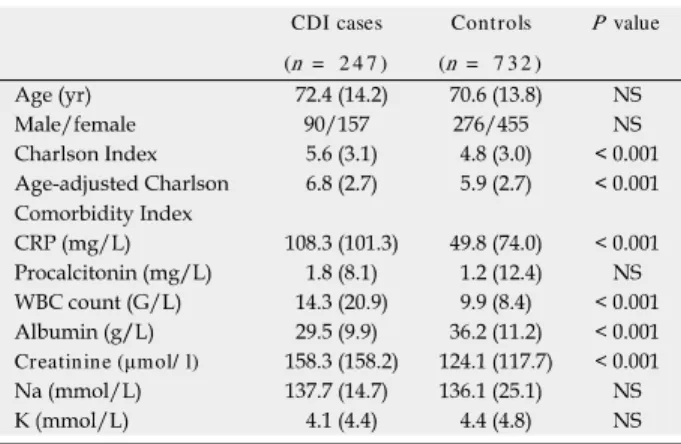A total of 247 inpatients had a con¿rmed diagnosis
CDI was de¿ned as an acute diarrheal disease (more
For de¿ning the possible risk factors a 1: 3 matching
Severe CDI was de¿ned as WBC 15 G/ L or above and serum album in level 30 g/ L or below based on
and death. Recurrence was de¿ned as a clinical relapse
mortality outcomes with LogRank test. A 0.05 was considered signi¿cant.
years old: 4.7% , 40-60 years old: 11.9% , > 60 years old: 83.4% ). Community acquired infection rate was
older (severe: 84.2% all: 69.6% of patients were
> 65 years,
Table 2 Risk factors for Clostridium difficile infection in inpatients
Table 1 Clinical and laboratory parameters of patients with Clostridium difſcile infection and controls
the patients required a change of the ¿rst therapy.
0.001) . Lengt h of t reatm ent
compared to the controls. Length of hospitalization was
CDI cases Controls P value (n = 2 4 7 ) (n = 7 3 2 )
Creatinine (µmol/ l)
Clostridium difÀcile C reactive protein; NS: N ot signiÀcant; WBC: White blood cell count.
Univariate analysis Multivariate analysis
difÀcile
Áuoroqu inolones. Previous treatm ent strategy was registered within 1 year from d iagnosis of CDI. Proton pum p inhibitor therap y w as d eÀned as at
Figure 1 Early mortality of patients with infection.
Primary infection vs relapse, within 30 d from admission. P log rank = 0.64. C.
Dif¿cile: Clostridium dif¿cile; CDI: Clostridium dif¿cile infection.
clavulanic acid, cephalosporins, ciproÀoxacin and Àu- Figure 2 Early mortality in hospitalized patients with Clostridium dif¿cile
infection according to the age at admission (within 30-d from admission).
P = 0.05 vs different age groups.
cases. Largely similarly treatment data were presented
Republic (overall: 19.7% , hospital-acquired: 22.4%
and in severe-CDI: 62% ) in a cohort with similar age
were identi¿ed by suggestive symptoms and cytotoxin
, ¿daxomicin,
Cases were identi¿ed through the full electronic online
rates were comparable to ¿ndings of previous studies.
associated with adverse outcomes, longer hospital stay and high mortality rate.
Antibiotic therapy, proton pump inhibitor treatment, previous hospitalization and CDI were risk factors for CDI.
Understanding the possible risk factors, disease course and outcomes of CDI and treatment strategy in these patient cohort may lead to better optimized treatment strategy and reduced healthcare associated complications.
Diagnosis of CDI based on clinical symptoms of diarrhea with positive cytotoxin stool assay or with diagnosis of pseudomembranosus colitis. Comorbidities were categorized according to Charlson Comorbidity and age adjusted Comorbidity Index. Severe infections were defined according to current infection specialists’ guidelines (severe leukocytosis and hypoalbuminaemia).
Recurrence was de¿ned as relapse of symptoms and positive stool test within 12 wk from discharge.
This is an epidemiological study regarding Clostridium difficile infection in Eastern Europe where its incidence is unclear. The authors present prospective data regarding incidence, risk factors, treatment and outcomes of Clostridium difficile infection. The paper covers an interesting topic and includes a considerable number of patients. They found that antibiotics and proton pump inhibitors were associated with CDI, which confirms the results of previous studies. The epidemiology of CDI is important because CDI remains a major nosocomial infection in the Western world and the epidemiology of CDI appears to be shifting more from healthcare- to community-acquired disease.
